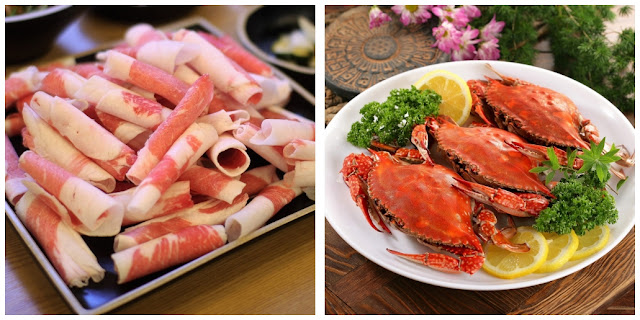- Get link
- X
- Other Apps
The most iconic and popular traditional Korean comfort food,
Doenjang-jjigae (Soybean paste stew).
How to easily make Doenjang-jjigae (Soybean paste stew).
When Korean think of home-cooked meals, what comes to mind the most?
It may differ from person to person, but I think Doenjang-jjigae (Soybean paste stew) with mother's taste will come to mind.
In additional to Kimchi-jjigae (Kimchi stew), the representative Korean food is Doenjang-jjigae.
According to a five-year poll, it was ranked No.1 in Korean food , which is Korean's favorite, in 2004, and No. 2 in 2019.
There is a song called "Mother's Doenjang-guk" and there is a song that has lyrics like "Mother's Doenjang-jjigae that boils in the morning".
The Korean's comfort food is definitely Doenjang-jjigae.
Definition : What is Doenjang-jjigae (Soybean paste stew)?
Doenjang-jjigae (된장찌개) is a dish made with Doenjang (된장 soybean paste), tofu, zucchini, onions, mushrooms, potatoes.
Main ingredient is Doenjang and sub ingredients can be changed and added according to preference, and the taste varies depending on the sub ingredient.
Sub ingredients are added to the name of Doenjang-jjigae, such as beef Doenjang-jjgae, clams Doenjang-jjigae etc.
However, tofu and onions tent to be put in any Doenjang-jjigae.
There are various recipes, some people only put Doenjang in them and some people put also Gochujang (red pepper paste) or Gochugaru (red pepper powder).
When you go to a barbecue place, most of them serve it for free.
There are many people who like it because it is salty and have a strong taste than normal Doenjang-jjigae.
What is Doenjang (된장 Soybean paste)?
Doenjang is kind of a paste that ferments Meju in salt water.
Meju is a brick of dried fermented soybeans.
Boil salted water using to ferment Doenjang trough a sieve and cool it down to became Ganjang (Soy sauce).
Similar foods around the world that ferment soybeans or bean such as Doenjang, include Miso in Japan, Doubanjiang in China.
Most modern Koreans use factory-made Doenjang instead of making it at home, but some the elderly still make homemade Doenjang.
Due to the difference in Doenjang recipe, the taste of Doenjang-jjigae is different.
Similar Dish
1) Doenjangguk (된장국) :
Unlike Doenjang-jjigae, it is less salty with a lot of broth and usually mixed with rice. Spinach, bean sprouts, cabbage, dried radish greens etc are used as ingredients, and unlike Doenjang-jjigae, it is not spicy.
2) Cheonggukjang (청국장) :
A traditional Korean food made by fermenting soybeans. Unlike Doenjang, it is a simple and quickly aged and has a very strong flavor. First-time encounters may find it difficult to eat because of the smell, and some children and young people avoid it, and some adults do not like it.
Variations
- Beef Doenjang-jjigae : Adding oily parts of beef deepens the taste of Doenjang-jjgae.
- Seafood Doenjang-jjigae : Crabs, clams, shrimp make soup delicious.
Recipe
- Prep Time : 10 minutes
- Cook Time : 20 minutes
- Total Time : 30 minutes
- Servings : 2
Ingredients
1 Tbs = 15ml
- 4 Tbs Doenjang (Soybean paste)
- 1 Tbs Ganjang (Soybean sauce)
- 400ml Ssaltteumul (Rice water) / or water
- 1 Tbs minced garlics
- 1 Tbs Korean chili pepper powder (Gochugaru)
- 7 Dried anchovies, guts removed
- 2 Dried kelp (1X2inch) (can be omitted)
- 100g (3.5 ounces) radishes (can be omitted)
- 250g (8.8 ounces) tofu, cut into 1-inch cubes
- ½ Medium onion, cut into 1-inch cubes
- ⅓ Medium zucchini, cut into 1-inch cubes
- ½ Medium potato, cut into 1-inch cubes (It is omitted in this post, but it would be better to add)
- 30g (1 ounces) scallions (green onion), thinly sliced
*Tip : how to make Ssaltteumul (Rice water)
- Ssaltteumul (쌀뜨물) : Rice water obtained from rinsing rice.
- Usage :
- Use it as base stock with dried anchovies and dried kelp when cooking soup
- Wash dishes (removing oil stains)
- How to obtain :
- Rinse the rise and pour out the water
- Throw away the first and second water
- Use the third water
Instruction
Step 1. Pour 400ml Ssaltteumul (or water) into a small pot and add dried anchovies, dried kelp, radish over high heat for 10 minutes.
Step 2. While stock is being made, cut tofu, onion, zucchini into 1-inch cubes and cut mushrooms. (In case of using potatoes, add it with other vegetables)
Step 3. Remove anchovies and kelp.
Step 4. Add radish and add onion, zucchini.
Source : Namuwiki















Comments
Post a Comment